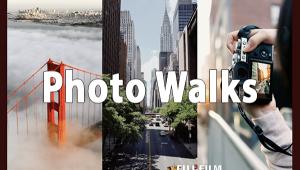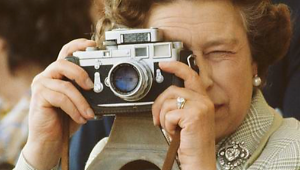7 Imaging Tech Trends That Will Change the Photo Industry in 2015

“I don’t think that digital technology will ever take away the humanity of storytelling, because storytelling is entirely, in and of itself, a wholly human concern.”—David Fincher
Since scratching the first drawings of animals onto cave walls, humans have been compelled to create images of their world for others to see and understand. During the past 150 years, the shape, size, and technology of the tools we have used to produce photographs has changed drastically. To capture sweeping landscape vistas, we no longer need to drive a mule-drawn darkroom wagon into the wilderness. Now a camera that fits in a pocket can do the job. During the coming year, the means that we will use to capture photographs may change but not the motivation to share a view of our world with other people.
But how much will our imaging tools be transformed in 2015? A little bit? A lot? I’ve looked into my crystal ball and picked out seven photo tech trends to keep your eye on this year. These trends just might change how we see and capture the world.

Mirrorless Camera Technology
The first 35mm SLR, the Ihagee Kine Exakta, was produced in 1936 and used a waist-level finder and a mirror because that was the best solution to the problem at that time. Modern “mirrorless” compact system cameras use a high-quality electronic viewfinder and mirrors are no longer required. This allows the design of smaller and lighter camera bodies with a shorter (under 20mm) flange focal distance that in turn allows production of smaller lenses. The Big Two (Canon and Nikon), while producing attempts at mirrorless photography gear, will likely still cling to traditional SLR concepts in 2015. But for many of us, bigger is not always better and it’s always heavier. Alfred Eisenstaedt didn’t have time to set up a view camera or even a TLR when photographing an American sailor kissing a nurse in Times Square on August 14, 1945. Yet, this unforgettable photograph was made with a Leica IIIa that measures 5.24x1.54x2.60 inches. By comparison, a mirrorless Olympus OM-D E-M10 is 4.76x1.64x3.52 inches. Some think the term “mirrorless camera” is synonymous with the Micro Four Thirds format that uses an 18x13.5mm sensor but it’s not. Mirrorless cameras use full-frame sensors as well as the APS-C (23.5x15.6mm) format. It won’t be enough to stick an EVF onto an SLR without making corresponding changes in the size of the camera and its lenses but I expect some manufacturers will try next year. As the image quality of mirrorless cameras gets better and better, no matter the sensor size, you should be asking why more cameras aren’t mirrorless in 2015.
4K Video
I used to think there were two distinct kinds of shooters—video and still—but now I’m not so sure and the line gets blurrier every year. With 4K video capabilities from affordable cameras like the Panasonic Lumix GH4 delivering stunning visual quality, you have to wonder where this trend is going in 2015. Not so much on the capture end—video shooters have that covered—but the real difference maker could be in playback. Next year, 4K television sets will become more affordable but what about non-user generated content? At CES, Samsung reportedly said 4K Blu-ray would be available by the end of the year but I haven’t seen any and many consumers don’t seem to mind (I’ll get to why in a bit). Netflix is streaming limited content in 4K but the Internet infrastructure in most of the US is slow compared to the rest of the world. According to Forbes, South Korea’s average connection speed is 14.2 Megabits/second while the USA’s is 7.4 Mbps. Even Latvia’s broadband is faster and I’m not optimistic the ISP monopolies in this country will improve, because it’s not the nature of monopolies, but we can always hope for better in 2015.

Stills From 4K Video
While my feelings about 4K video, per se, may seem less than enthusiastic, my take on the still side of those video clips is the opposite. The ability to grab a single high-quality frame from a 4K video clip is nothing new; people have frame grabbed for years. What’s different is the quality of that grabbed frame. People, such as the good folks at Pro Photo Supply in Portland, are making 60-inch-wide prints from frames of 4K video shot with a Panasonic Lumix GH4. Think about that and ask yourself: What decisive moment? Someone could shoot a video of a guy jumping a puddle and then pull one frame—the decisive frame—that’s the perfect moment. But you say, it might be in between frames. The GH4 shoots slow motion at 96 frames per second. Maybe not at 4K but it’s 1080p (1920x1080). The best part of it is that software such as Adobe’s Lightroom makes selecting and processing frame grabs “easy peasy lemon squeezy.” What about all those great sports shots snapped by pros at an athlete’s peak action? They may be within a Soccer Mom’s reach in 2015.

3D Printing
We’ve been printing 2D objects, including photographs, with our computers since Epson launched the first Stylus Color printer in 1993. What’s next? A 3D printer is a type of industrial robot for the desktop that can fashion a three-dimensional object in almost any shape. Right now, one of the pioneers in 3D printing, MakerBot, is selling 3D printers in Home Depot stores in California, Illinois, and New York. MakerBot and Adorama launched an in-store partnership where 3D printers and scanners will be demonstrated and sold. Many photographers, although I’m not one, like to tinker and make their own gadgets and gizmos and 3D printing will let them produce these kinds of products or maybe even finished objects. Out here in the real world, scientists are using 3D printing to create surgical orthopedic replacements and devices such as a 300-watt backpackable wind turbine. On a more mundane level, 3D printing will allow portrait and wedding photographers to create custom tchotchkes as new profit centers. This is a unique tool that is just waiting for the right photographic application and, once revealed, will seem so obvious that everyone will wonder why nobody thought of it before.

Smartphone/Tablet Integration
While not new, the integration of the smartphone into photography goes back to the 2012 introduction of onOne Software’s DSLR Camera Remote, or perhaps even further with software tools like CamRanger ($299.99) changing the imaging landscape. CamRanger’s software and hardware can wirelessly control Nikon or Canon SLRs, integrating tablets and smartphones into the process in ways you could only previously imagine. CamRanger hardware is required to use the CamRanger iOS, Android, Mac, or Windows app but no computers or Internet are needed; you connect your camera to CamRanger and then set parameters (ISO, aperture, shutter speed, white balance, focus, etc.) then view 100 percent resolution images with metadata, including histogram. It’s got all the goodies you might expect such as Focus Stacking, Intervalometer for Time Lapse, and Advanced Bracketing/HDR controls. On a more basic and inexpensive level, the Pentax FluCard Pro SDHC Memory Card ($99.95) allows wireless connectivity between select Pentax cameras and a mobile device or computer. It allows for remotely changing settings such as ISO, shutter speed, aperture, exposure compensation, and focus points. In addition to storing Raw and JPEG files, the card can transfer full-size JPEG files to the connected device. Look for more and more companies to find new ways to integrate smartphone and tablet operation in 2015.

Drones
You can call ’em drones but I prefer to call ’em what they really are: radio-controlled model aircraft. Drones such as DJI’s Phantom 2 quadcopter are available right now to fly while shooting video and still images. But wait, you say, the FAA specifically banned the use of UAVs (Unmanned Aerial Vehicle, to give these craft yet another name) for commercial purposes, even for something as mundane as real estate photography. Yet, an NTSB Administrative Law Judge dismissed all charges against someone charged for doing just that, stating there was “no enforceable FAA rule” that applied to a model aircraft. So which government agency do you listen to? Congress has directed the FAA to develop rules for the commercial use of small (under 55 pounds) drones by September 2015. Amazon’s Jeff Bezos told “60 Minutes” he was planning package delivery by drone but not before “2015 at the very earliest.” So start flying your drone now and snapping still photographs and videos—non-commercially, to be absolutely safe—and see what the fun is all about and be ready for a drone photography trend this year.

LED Lighting
Initially, LED didn’t technically seem to be the best possible artificial lighting source for portraiture but improvements in both the quality of the individual light-emitting diodes and the packages they’re wrapped in are moving at (dare I say it?) light speed. I’ve always held that every improvement in imaging has been more about convenience than quality and the convenience factor for LEDs is high. LED studio lights let you see the light falling on your subject exactly how it will appear in the final image and you can use the in-camera meter to arrive at the proper exposure so the process is welcoming to the aspiring professional. LED sources such as Rotolight’s Anova and their inexpensive RL48 make it easy and, in the case of the RL48, affordable to capture images using LEDs. As we roll into photokina season, Rotolight’s new midsized NEO provides the company with a three-tiered series of affordable lighting devices. There are sure to be less expensive options to come, forcing downward pressure on price points with devices such as Flashpoint’s $400 Model 1144 LED Circular Light (look for a review in an upcoming issue of Shutterbug). Moore’s Law states that “overall processing power for computers will double every two years” and I expect that same thing to happen with LED light sources at an even faster pace in 2015.

- Log in or register to post comments

















































